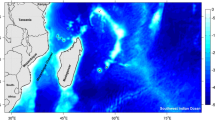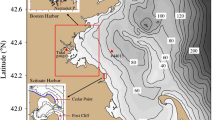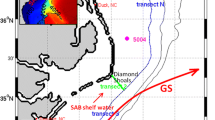Abstract
In this study, the non-linear tide-surge interactions (NTSIs) over the eastern Canadian shelf (ECS) are examined numerically during two extreme weather events. A three-dimensional ocean circulation model for the ECS based on the Regional Ocean Modeling System (ROMS-ECS) is used. The model is driven by tides and atmospheric forcing in a barotropic mode by neglecting baroclinic effects on NTSIs in this study. The atmospheric forcing is based on the hourly atmospheric reanalysis known as ERA5 produced by the European Centre for Medium-Range Weather Forecasts. The performance of ROMS-ECS in simulating tides and storm surge is assessed using observed sea levels and previous numerical results over the ECS. Analyses of model results during Hurricanes Bill (2009) and Dorian (2019) demonstrate that relatively strong NTSIs occur over regions with strong tidal and wind-driven currents. The relatively intense NTSIs also modulate the magnitudes and timings of maximum storm surges as well as the amplitudes and phases of tides during the storm. In addition, the three-dimensional (3D) currents are modulated greatly by the NTSIs over the shelf break region. It is found that the non-linear friction and advection are the dominant factors in the NTSIs during the two storms. Relatively strong NTSIs also occur after the passage of the storm due to shelf waves generated by non-local storm winds.




















Similar content being viewed by others
Data availability
The datasets generated during and/or analyzed during the current study are available from the corresponding author on reasonable request.
References
Arbic BK, St-Laurent P, Sutherland G, Garrett C (2007) On the resonance and influence of the tides in Ungava Bay and Hudson Strait. Geophys Res Lett 34:606
Bernier NB, Thompson KR (2007) Tide‐surge interaction off the east coast of Canada and northeastern United States. J Geophys Res 112:C06008
Bilskie MV, Hagen S, Alizad K, Medeiros S, Passeri DL, Needham H, Cox A (2016) Dynamic simulation and numerical analysis of hurricane storm surge under sea level rise with geomorphologic changes along the northern Gulf of Mexico. Earths Future 4:177–193
Bintanja R, Van De Wal RS, Oerlemans J (2005) Modelled atmospheric temperatures and global sea levels over the past million years. Nature 437:125–128
Brickman D, Hebert D, Wang Z (2018) Mechanism for the recent ocean warming events on the Scotian Shelf of eastern Canada. Cont Shelf Res 156:11–22
Dupont F, Hannah CG, Greenberg DA, Cherniawsky JY, Naimie CE (2002) Modelling system for tides for the Northwest Atlantic coastal ocean, Can Tech Rep Hydrogr Ocean Sci 221:72. Available at https://publications.gc.ca/collections/collection_2007/dfo-mpo/Fs97-18-221-2002E.pdf. Accessed 2 May 2023
Easton A (1972) Seiches of Sydney Harbor, NS, Canadian. J Earth Sci 9:857–862
Egbert GD, Erofeeva SY (2002) Efficient inverse modeling of barotropic ocean tides. J Atmos Ocean Technol 19:183–204
Feng J, Jiang W, Li D, Liu Q, Wang H, Liu K (2019) Characteristics of tide–surge interaction and its roles in the distribution of surge residuals along the coast of China. J Oceanogr 75:225–234
Garrett C (1972) Tidal resonance in the Bay of Fundy and Gulf of Maine. Nature 238:441–443
Haidvogel DB, Arango H, Budgell WP, Cornuelle BD, Curchitser E, Di Lorenzo E, Fennel K et al (2008) Ocean forecasting in terrain-following coordinates: Formulation and skill assessment of the Regional Ocean Modeling System. J Comput Phys 227:3595–3624
Han G, Paturi S, De Young B, Yi Y, Shum CK (2010) A 3-D data-assimilative tidal model of the northwest Atlantic. Atmos - Ocean 48:39–57
Hasegawa D, Sheng J, Greenberg DA, Thompson KR (2011) Far-field effects of tidal energy extraction in the Minas Passage on tidal circulation in the Bay of Fundy and Gulf of Maine using a nested-grid coastal circulation model. Ocean Dyn 61:1845–1868
Hedström KS (2018) Technical manual for a coupled sea-ice/ocean circulation model (version 5). U.S. Dept. of the Interior, Bureau of Ocean Energy Management, Alaska OCS Region. OCS Study BOEM 2018-007:182
Hersbach H, Bell B, Berrisford P, Hirahara S, Horányi A, Muñoz-Sabater J, Nicolas J, Peubey C, Radu R, Schepers D (2020) The ERA5 global reanalysis. Q J R Meteorol Soc 146:1999–2049
Horsburgh K, Wilson C (2007) Tide‐surge interaction and its role in the distribution of surge residuals in the North Sea. J Geophys Res 112:C08003
Hu K, Chen Q, Kimball SK (2012) Consistency in hurricane surface wind forecasting: an improved parametric model. Nat Hazards 61:1029–1050
Idier D, Dumas F, Muller H (2012) Tide-surge interaction in the English Channel. Nat Hazards Earth Syst Sci 12:3709–3718
Jacob B, Stanev EV (2017) Interactions between wind and tidally induced currents in coastal and shelf basins. Ocean Dyn 67:1263–1281
Jones JE, Davies AM (2007) Influence of non-linear effects upon surge elevations along the west coast of Britain. Ocean Dyn 57:401–416
Karim MF, Mimura N (2008) Impacts of climate change and sea-level rise on cyclonic storm surge floods in Bangladesh. Glob Environ Change 18:490–500
Lambeck K, Esat TM, Potter EK (2002) Links between climate and sea levels for the past three million years. Nature 419:199–206
Large W, Pond S (1981) Open ocean momentum flux measurements in moderate to strong winds. J Phys Oceanogr 11:324–336
Lee BS, Haran M, Keller K (2017) Multidecadal scale detection time for potentially increasing Atlantic storm surges in a warming climate. Geophys Res Lett 44:617–623
Lin S, Sheng J, Xing J (2020) Performance evaluation of parameterizations for wind input and wave dissipation in the spectral wave model for the northwest Atlantic Ocean. Atmos - Ocean 58:258–286
McInnes K, Walsh K, Hubbert G, Beer T (2003) Impact of sea-level rise and storm surges on a coastal community. Nat Hazards 30:187–207
Mellor GL, Yamada T (1982) Development of a turbulence closure model for geophysical fluid problems. Rev Geophys 20:851–875
Nerem RS, Leuliette É, Cazenave A (2006) Present-day sea-level change: a review. C R Geosci 338:1077–1083
Ohashi K, Sheng J, Thompson KR, Hannah CG, Ritchie H (2009) Effect of stratification on tidal circulation over the Scotian Shelf and Gulf of St. Lawrence: a numerical study using a three-dimensional shelf circulation model. Ocean Dyn 59:809–825
Orlanski I (1976) A simple boundary condition for unbounded hyperbolic flows. J Comput Phys 21:251–269
Pawlowicz R, Beardsley B, Lentz S (2002) Classical tidal harmonic analysis including error estimates in MATLAB using T_TIDE. Comput Geosci 28:929–937
Powell MD, Vickery PJ, Reinhold TA (2003) Reduced drag coefficient for high wind speeds in tropical cyclones. Nature 422:279–283
Rasquin C, Seiffert R, Wachler B, Winkel N (2020) The significance of coastal bathymetry representation for modelling the tidal response to mean sea level rise in the German Bight. Ocean Sci 16:31–44
Rego JL, Li C (2010) Nonlinear terms in storm surge predictions: effect of tide and shelf geometry with case study from Hurricane Rita. J Geophys Res 115:C06020
Rossiter JR (1961) Interaction between tide and surge in the Thames. Geophys J Int 6:29–53
Sheng J, Zhai X, Greatbatch RJ (2006) Numerical study of the storm-induced circulation on the Scotian Shelf during Hurricane Juan using a nested-grid ocean model. Prog Oceanogr 70:233–254
Smagorinsky J (1963) General circulation experiments with the primitive equations: I. The Basic Experiment. Mon Weather Rev 91:99–164
Thompson KR, Sheng J (1997) Subtidal circulation on the Scotian Shelf: Assessing the hindcast skill of a linear barotropic model. J Geophys Res 102:24987–25003
Wang Y, Sheng J, Lu Y (2020) Examining tidal impacts on seasonal circulation and hydrography variability over the eastern Canadian shelf using a coupled circulation-ice regional model. Prog Oceanogr 102448. https://doi.org/10.1016/j.pocean.2020.102448
Wang P, Sheng J (2016) A comparative study of wave-current interactions over the eastern Canadian shelf under severe weather conditions using a coupled wave-circulation model. J Geophys Res 121:5252–5281
Wolf J (1978) Interaction of tide and surge in a semi-infinite uniform channel, with application to surge propagation down the east coast of Britain. Appl Math Model 2:245–253
Wolf J (2009) Coastal flooding: impacts of coupled wave–surge–tide models. Nat Hazards 49:241–260
Zhang H, Sheng J (2013) Estimation of extreme sea levels over the eastern continental shelf of North America. J Geophys Res 118:6253–6273
Zhang W, Teng L, Zhang J, Xiong M, Yin C (2019) Numerical study on effect of tidal phase on storm surge in the South Yellow Sea. J Oceanol Limnol 37:2037–2055
Zhang X, Chu D, Zhang J (2021) Effects of nonlinear terms and topography in a storm surge model along the southeastern coast of China: a case study of Typhoon Chan-hom. Nat Hazards 107:551–574
Zhang WZ, Shi F, Hong HS, Shang SP, Kirby JT (2010) Tide‐surge interaction intensified by the Taiwan Strait. J Geophys Res 115:C06012
Acknowledgements
This research was supported by the Ocean Frontier Institute (OFI), Marine Environmental Observation Prediction and Response Network (MEOPAR), and Mathematics of Information Technology and Complex Systems (MITACS). J. S. is also supported by the Natural Sciences and Engineering Research Council of Canada (NSERC). The sea level observations are provided by the Marine Environmental Data Service of Fisheries and Oceans Canada (DFO). The authors thank two anonymous reviewers for their constructive comments and suggestions.
Author information
Authors and Affiliations
Corresponding authors
Ethics declarations
Conflicts of interest
The authors declare that they have no conflict of interest.
Additional information
Responsible Editor: Ricardo de Camargo
This article is part of the Topical Collection on the 12th International Workshop on Modeling the Ocean (IWMO), Ann Arbor, USA, 25 June – 1 July 2022.
Appendices
Appendix A: Error statistics for model comparisons
The root mean square error (RMSE), correlation coefficient (R), and γ2 (Thompson and Sheng 1997) are used in this study to quantitatively assess the model performance.
where N is the total number of observations, M and O denote respectively the modeled and observed values, and the overbar in Eq. (A-2) represents temporal averaging. Var represents the variance operator. Physically, the γ2 value in Eq. (A-3) represents the ratio between the variance of the model hindcast errors and the variance of the observations. The smaller γ2 is, the better is the model performance. Empirically, the threshold value of γ2 is chosen to be 1.
Appendix B: Co-amplitudes and Co-phases of M2 and K1 tides in baroclinic run
The baroclinic effect is not considered in this study. Past studies suggested that the tidal circulation over the ECS is affected by the hydrography and its seasonal variability (Ohashi et al. 2009; Wang et al. 2020). To demonstrate the effect of stratification and associated seasonal variability on the tidal elevations, the ROMS-ECS is run in baroclinic mode, with external forcing described in Section 3 and additional forcing associated with the net heat and freshwater fluxes at the sea surface and freshwater discharges from major rivers. From the hourly sea levels produced by the ROMS-ECS in February and August 2019, co-amplitudes and co-phases of tidal sea levels for the two major constituents M2 and K1 are calculated.
Co-amplitudes and co-phases of M2 tidal sea levels in the baroclinic run (Fig.
B1a, c) in February and August 2019 have large-scale features almost identical to their counterparts in the barotropic run (Fig. 3a). The amplitudes of the M2 tides in the baroclinic run are slightly larger than their barotropic counterparts in the LC (thought to be due to the influence of baroclinic pressure gradient), while the phase of M2 tides leads its counterpart in the barotropic run over LS.
Co-amplitudes and co-phases of K1 tidal sea levels in the baroclinic run (Fig. B1b, d) in February and August 2019 also have features almost identical to their counterparts in the barotropic run (Fig. 3b) over the deep ocean waters of the northern North Atlantic and Labrador Sea, except for the noticeable differences over BB and ESL. Over these regions, the simulated amplitudes of K1 produced by the ROMS-ECS in baroclinic mode are larger than in barotropic mode due to the baroclinic effect of stratification in the former.
In the baroclinic run, the co-amplitudes and co-phases of the M2 tide in February (Fig. B1a) over the LC is smaller than in August (Fig. B1c). The differences in the co-amplitudes and co-phases of the K1 tide between February (Fig. B1b) and August (Fig. B1d) show that the K1 tidal elevations have larger amplitudes in BB and ESL in summer than winter. The comparisons of the M2 and K1 tides in the baroclinic run between February and August indicate that the tides are affected by the seasonal variability in stratification (Ohashi et al. 2009).
Rights and permissions
Springer Nature or its licensor (e.g. a society or other partner) holds exclusive rights to this article under a publishing agreement with the author(s) or other rightsholder(s); author self-archiving of the accepted manuscript version of this article is solely governed by the terms of such publishing agreement and applicable law.
About this article
Cite this article
Yang, S., Sheng, J., Ohashi, K. et al. Non-linear interactions between tides and storm surges during extreme weather events over the eastern Canadian shelf. Ocean Dynamics 73, 279–301 (2023). https://doi.org/10.1007/s10236-023-01556-w
Received:
Accepted:
Published:
Issue Date:
DOI: https://doi.org/10.1007/s10236-023-01556-w





